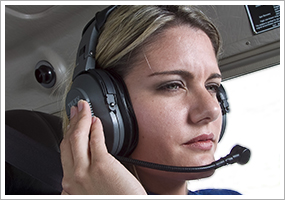Oct. 8, 2010, issue of 'AOPA ePilot: Flight Training edition' e-newsletter
| ||||
| | FT News | INSIDE AOPA | TRAINING PRODUCTS | FINAL EXAM | |||
TRAINING TIPsFighting frequency congestion
Frequency congestion is a real headache—and it’s a constant reminder that a careful visual lookout is critical when operating under visual flight rules. Often the cause of frequency congestion is that numerous airports in the same area share a frequency, especially the unicom and common traffic advisory frequency (CTAF) 122.8 MHz. Many student pilots notice this and ask why 122.8 MHz tends to be “hotter” than other CTAFs. “Originally, 122.8 MHz was the standard unicom frequency for all airports. As flying activity and the number of airports increased, 122.7 MHz and 123.0 MHz were added to accommodate the increased traffic. Although three Unicom frequencies were unable to handle the general aviation Unicom traffic, additional frequencies were unavailable,” explains AOPA Online’s Air Traffic Services and Technology page. Complicating matters is that an airport sharing your frequency may have a runway with the same magnetic bearing as yours. Listen closely to announcements from pilots on the frequency for the airport in use. Sometimes you’ll hear an air traffic controller or a fellow pilot inform an aircraft over the radio that a transmission was stepped on or “blocked.” So common is the problem that you can even find the term in the Pilot/Controller Glossary: “BLOCKED—Phraseology used to indicate that a radio transmission has been distorted or interrupted due to multiple simultaneous radio transmissions.” The AOPA Online brief cited above notes that the situation is improving with changes that doubled the number of channels available to aviation. “AOPA successfully lobbied for additional frequencies when this change took place. Four more unicom frequencies became available: 122.725 MHz, 122.975 MHz, 123.050 MHz, and 123.075 MHz.” An example is Pinal Airpark in Marana, Ariz., using 123.05 MHz for CTAF and unicom. Check AOPA Airports and your charts for current airport frequency information. Then review the Air Safety Institute’s Safety Hotspot: Operations at Nontowered Airports for a complete safety check before your next flight. YOUR PARTNER IN TRAININGAll aviation colleges are not alike. Some programs are small, others are large; and the aircraft you will fly can vary widely among schools. How can you figure out what’s best for you? Try the Aviation College Resources at Flight Training Online, and don’t forget to search the magazine archives for pertinent articles.
Did you know that student pilots who join AOPA are three times more likely to complete their flight training? Membership includes unlimited access to aviation information by phone (800/USA-AOPA, weekdays from 8:30 a.m. to 6 p.m. Eastern time) or from AOPA Flight Training Online or AOPA Online. If you're not already a member, join today and get the pilot's edge. Login information is available online. FLIGHT TRAINING NEWSPressure mounts as EU vote on pilot certification nearsWith the European Union Commission nearing a vote on adopting EU-wide pilot certification rules, AOPA is warning that the package—which does not include acceptance of third-country pilot credentials—would erect trade barriers with consequences felt in the U.S. flight training and manufacturing sectors. If passed into law, the proposal would require pilots who complete their flight training in the United States to repeat most of the exact same training upon returning to an EU state, and it would render the FAA instrument rating useless in Europe. Read more >> Lockheed Martin FSS contract renewedThe FAA has extended Lockheed Martin’s five-year contract to run the nation’s automated flight service stations until 2013. Another two-year option is possible when this extension expires. Lockheed Martin took over the system under an agreement awarded in 2005. The preceding five years have heralded considerable change. Read more >> South Dakota transportation official solos A first solo is always a time for celebration. When the student pilot happens to be South Dakota’s second-ranking transportation official who is also participating in the state’s effort to promote aviation, the occasion becomes even more of a special event. Read more >> AOPA Aviation Summit must-see: Rod Machado Flight Training and AOPA Pilot readers enjoy Rod Machado’s wit and wisdom within the pages of every issue. But you won’t want to miss an opportunity to hear Machado in person at this year’s AOPA Aviation Summit in Long Beach, Calif. He’ll share his brand of “Aviation Humor” on Thursday, Nov. 11, at 2 p.m. in the Long Beach Convention Center. Not sure what else to see at Summit? View more top picks from aviation personalities. CFIs are habit-forming Over the years, CFIs and other professionals have taught Flight Training contributor Ralph Hood several good practices, including the basics and additional tips and tricks. For instance, some of flying’s most important moments take place during the preflight checklist, and interrupting that flow can be critical. In one job, Hood regularly flew a Luscombe, Piper Comanche, Beechcraft Bonanza, 150-horsepower Cessna Cardinal, and any of several different ag planes. One way to ensure he went through the critical items on the checklist was the well-known acronym CIGAR TIP. Read more >> Inside AOPA Talk the talk with ATC Terminology Safety Quiz Communicating with air traffic control is a breeze when you understand the meaning and purpose of the language used. But, when was the last time you studied the Pilot/Controller Glossary to beef up on ATC jargon? Do you know why your instructor loves it when the tower clears you “for the option”? What exactly does “pilot’s discretion” mean? Find out and get on the same page with ATC— take the quiz now. This quiz is underwritten by the AOPA Insurance Agency. A word to the wise about carb ice The word “ice” generally is used in conjunction with airframe icing, but it isn’t just chilly outside temperatures with moist air that can cause ice. For example, hot outside temperatures—even running in the triple digits—with humidity levels around 50 percent should have you primed for carb icing. But what are the telltale signs of carb icing? Hold the keys to combat carb ice by examining the Air Safety Institute’s topical Safety Brief. You will understand the danger, recognize the symptoms, and take corrective and prompt action. | Got news? Contact ePilot. Having difficulty using this service? Visit the ePilot Frequently Asked Questions now at AOPA Online or write to [email protected]. |
| This issue of ePilot was created for &fname; &lname; at &*TO; Member Tools : Send feedback | ePilot Archive Editorial Team: ePilot Flight Training Editor : Jill W. Tallman | ePilot Editor: Sarah Brown | Contributor: Alton K. Marsh |

 Arriving or departing a busy airport can tax any pilot’s skills. And when a hole finally opens up in the traffic flow, it may still be impossible to get a word in edgewise on the radio to announce your intentions or get an airport advisory (see the Sept. 16, 2005, "
Arriving or departing a busy airport can tax any pilot’s skills. And when a hole finally opens up in the traffic flow, it may still be impossible to get a word in edgewise on the radio to announce your intentions or get an airport advisory (see the Sept. 16, 2005, " 


